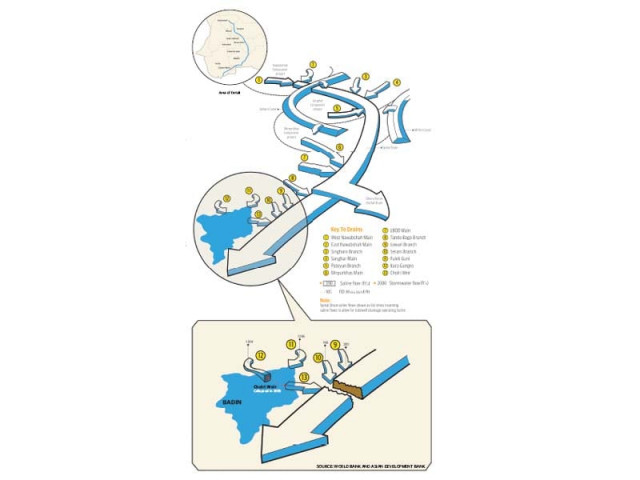LBOD: The culprit behind recurring floods in Sindh?
The Left Bank Outfall Drain has several design flaws that cause leakages, but are there any solutions?.

Did poor design of an internationally-funded drainage system really exacerbate the devastation from the floods in Badin or is it simply a convenient excuse to blame ‘arrogant’ foreigners for a natural calamity?
A review by The Express Tribune of technical documents prepared by the World Bank and the Asian Development Bank about the Left Bank Outfall Drain (LBOD) project reveals that while the international lenders may indeed share some of the blame for the damages, much of the damage may have been caused by natural topography, the politics of Partition, and negligence on the part of the government.
The LBOD has been blamed by civil society groups since the 1990s for altering the drainage and water flow patterns in lower Sindh – specifically Badin and Thatta – and worsening the flooding in those two districts. Yet the matter is somewhat more complicated. The LBOD, for instance, has brought about massive benefits for middle Sindh, especially Nawabshah, Sanghar and Mirpurkhas, and has allowed nearly half a million hectares to be brought back under cultivation that had been abandoned due to water-logging and salinity.
Correcting flaws in the Sukkur Barrage
The Sukkur Barrage – the largest in the world – is often considered an engineering wonder by most Pakistanis. Yet many seem unaware that its associated canal system has a serious design flaw: because nearly all of the canals are earthen, rather than lined with concrete, they cause the water table in the areas they irrigate to rise, eventually rendering them so waterlogged as to be uncultivable.
This problem was initially left completely unchecked, and for the first three decades, farmers would frequently create makeshift drains to drain out the excess saline water back into the canals, exacerbating the problem in the process.
In the 1960s, the government decided to create a more permanent solution to the water-logging/salinity problem. A 100-mile spinal drain was built in the 1970s in middle Sindh, but suffered from a political flaw: part of the water was drained into the Shakoor Dhand, a body of water that Pakistan shares with India.
In the early 1980s, therefore, the government began exploring other options for drainage, especially focusing on stretching the spinal drain out to sea.
Construction on the LBOD began in 1985 and was completed only in 2002, about nine years behind schedule. The project was initially meant to cost about $654 million, but ran 47% over cost, eventually costing $963 million. It was partially financed by a consortium of eight international lenders, including the World Bank and the ADB, though most of the cost was borne by the government.
One weak link
The problem with the LBOD is not the entirety of the drain but rather one specific portion of it, known as the Tidal Link, which connects the drain to the sea. The drain suffers from several design flaws which cause it to start spilling water into the neighbouring region rather than taking it out to sea, a problem acknowledged by both the World Bank and the ADB.
The original design of the LBOD anticipated this problem and created what was known as the Cholri Weir, to prevent the water from leaking into and damaging the surrounding area, most of which consists of dhands – small bodies of water that grow in size depending on the rainfall level.
The problem, however, is that the Cholri Weir was destroyed in 1999 by a cyclone and the government decided – for reasons that now appear flawed – not to repair it, a decision supported by the international lenders.
In normal years, the absence of the Cholri Weir is not a substantial problem, since the water still flows out to sea. However, any rainfall that exceeds 125 mm over a 24-hour period renders the Tidal Link useless, even harmful.
During heavy rains, the dhands themselves swell to several times their normal size and, coupled with the excess flow of water leaking from Link, contribute to the flooding in Badin district, usually one of the worst hit areas of Sindh in any flood. The degree to which the design flaw contributes to the flooding, however, remains a matter disputed between civil society groups and international financial institutions.
Another of the design flaws is that the Tidal Link flows against the natural drainage patterns of the region, though this cannot really be fixed: following the natural drainage would lead the link to flow into India, an arrangement New Delhi is unlikely to agree to.
Concrete solutions
Neither the World Bank nor the Asian Development Bank offer any solutions – at least not directly. Most NGOs protesting the LBOD complain the global lenders violated their own rules for engaging the community before the construction of the drain (a problem that the ADB and the World Bank acknowledged in nearly every report), yet seem to ignore the fact that the drain was needed in the first place.
The solution, it appears, is likely to be an expensive one: lining the canals with concrete. The World Bank’s assessment of the programme, conducted in 2006, stated that had the Cholri Weir been a concrete structure rather than mud-built, it would have withstood the storms that frequently hit the district.
It is unclear if the government has the will, or the money, to implement such a solution.
Published in The Express Tribune, September 30th, 2011.


















COMMENTS
Comments are moderated and generally will be posted if they are on-topic and not abusive.
For more information, please see our Comments FAQ